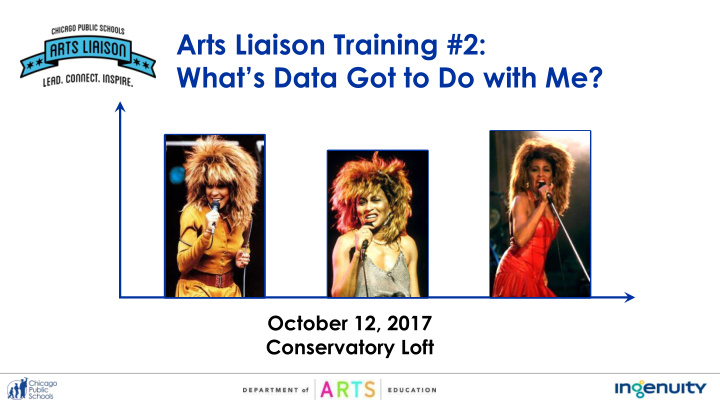



Arts Liaison Training #2: What’s Data Got to Do with Me? October 12, 2017 Conservatory Loft
Arts Liaison Training #2: What’s Data Got to Do with Me? Training and Summit goal for the year: Inspire and empower Arts Liaisons to increase their leadership impact on their school community and in the district. KNOW: Where to find arts data for the district, your network, and your school UNDERSTAND: How to engage with the most relevant data for your school community DO: Continue to develop your action plan (working toward a presentation to stakeholders in your school community)
Arts Liaison Training #2: What’s Data Got to Do with Me? Training and Summit goal for the year: Inspire and empower Arts Liaisons to increase their leadership impact on their school community and in the district. Develop an action Execute action Present your Arts plan to increase plan and develop Liaison leadership your engagement strategies and skills impact story to as an Arts Liaison for presenting to stakeholders in the stakeholders school community Sept–Oct 2017 Oct 2017–Feb 2018 March-May 2018
Data: More Than Numbers Definitions of different types of data— and why it all matters
Data: More than Numbers Photo courtesy of Barrel of Monkeys
Data: More than Numbers Quantitative Data Quantitative data can be measured and written down with numbers. These data commonly ask, “how much?” and “how many?” and can be used to study levels of achievement or occurrence. Qualitative Data Qualitative data describe the quality of something, often using words and narratives. They provide understanding that goes beyond numbers, thus presenting an in-depth and nuanced view of the world.
Using Data to Craft a Narrative How to tell a compelling story to stakeholders
Using Data to Craft a Narrative Three components of compelling impact stories 1. Use a mix of quantitative and qualitative data ○ Go beyond a laundry list of data points by providing descriptions and narratives 1. Provide context ○ Historical and/or cross-sectional 1. Answer the question, “so what?” ○ How does this fit into the broader context?
Using Data to Craft a Narrative Photo courtesy of Barrel of Monkeys
This IS the Data You’re Looking For. Where to find relevant data for your district, network, and school
This IS the Data You’re Looking For.
This IS the Data You’re Looking For. ● View your Creative Schools Certification ● Download Rubric and Raw Data Report ● Find data from previous years
This IS the Data You’re Looking For. School- and District-level data is published online! Visit: cps.edu/SchoolData
This IS the Data You’re Looking For. SQRP, School Progress Reports NWEA, PARCC, ACT, Algebra Exit Limited English, IEP, Low Income, Racial/Ethnic, 20th Day data AP, College Enrollment, Graduation Rates, On-Track, Mobility 5Essentials (My School, My Voice)
Action Planning: The Why and the How Why does my goal matter? How will I get there?
The Steps of Action Planning Step What When Set Create a SMART goal addressing Arts Liaison Training #1 Goal strategic priority of increasing active engagement of Arts Liaisons. Act Create an Action Plan outlining Arts Liaison Training #2 steps that need to be taken to meet the goal. Reflect Reflect on the quality of Arts Liaison Training #6 implementation of the Action Plan. (check-ins #3–5)
Action Planning and Storytelling The story Identify issues Set SMART goal Create an action plan for the year
Action Planning: Why Does My Goal Matter?
Action Planning: Why Does My Goal Matter? Share out: What is your goal? Why is it important to you?
Action Planning: How Will I Get There?
Action Planning: How Will I Get There? Goal: To make sure all our Arts Essentials money is spent down by the end of the 17-18 school year. Specific example Non-specific example
Action Planning: Next Steps What When Finish your SMART goal and action plan. By Training #3 (Nov 9) Digital copies on cpsarts.org. Start executing your plan! Now until end of year Build a toolbox of presentation skills; Trainings #3-5 check-ins on action planning Reflect on action planning process Training #6 (Mar 22)
Reflection on Training #2 ● Staying for the Summit? Turn in your reflection form at the Creative Corner and get an extra voucher for your school! ● Leaving now? Complete the reflection form at cpsarts.org—it’s located in the new Arts Liaison Toolkit.
Important Updates at cpsarts.org Arts Liaison Toolkit Lesson Labs Download all materials from Propose a Lesson Lab at Liaison Trainings and Summits your school and register for and other useful information. upcoming Lesson Labs.
Important Reminders Arts Liaison Training #3 and Theatre Summit November 9th, 2017 ● Visit cpsarts.org for all registration details ● Register by Tuesday 11/7/17 at 12pm for an extra voucher
Important Reminders Arts Education Conference 2017 November 3–4, 2017 at Juarez HS Keynote Speakers: Friday: Lara Davis Saturday: Dr. Eve Ewing Seattle Office of Arts & Culture University of Chicago
Important Reminders ● All-City Performing Arts: Register now! ● Complete your surveys on Learning Hub within 14 days and on ISBE within 60 days! ● Visual Arts Summit starts at 6pm. If you want to stay, please register at the check-in desk. Follow us on Facebook! www.facebook.com/ArtsCPS/
Recommend
More recommend